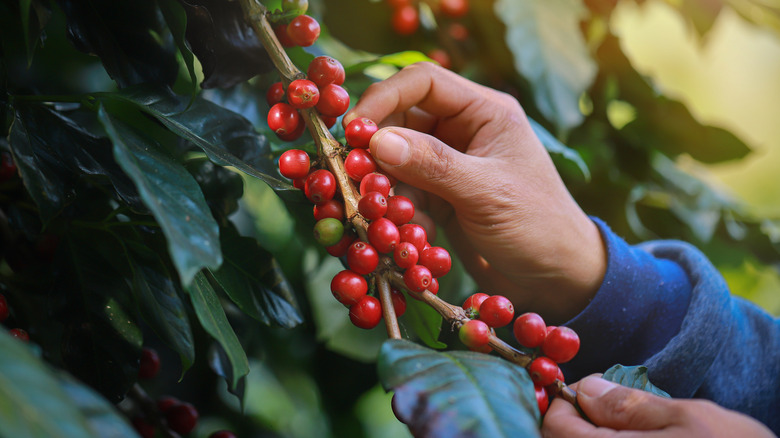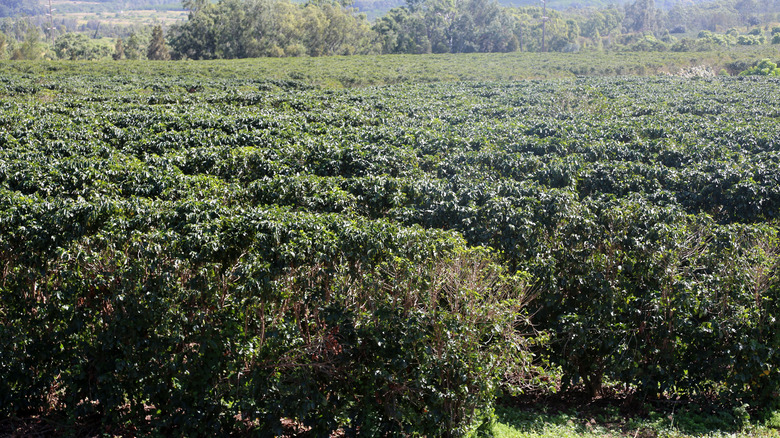What Is Terroir And Does It Matter For Coffee Beans?
Coffee means different things to different people. To some, it is a beverage taken iced or hot; to others it is a pick-me-up that comes with a range of extras like milk or flavored syrups. Others pay attention to the manner and intensity with which beans are roasted. But there is a group of coffee connoisseurs around the world that look beyond all those factors, because they believe the flavor and aroma of coffee can be determined by its origin, and to these coffee fans terroir is what sets one type of coffee bean apart from another.
Terroir is a familiar concept to those who know their wines. Per JJ Buckley, it is the idea that there are different physical factors that can determine the outcome of the way grapes are grown: the climate grapes are grown in, the soil in which vines are planted, even how high the vineyards are. Coffee experts say the same can be said for the coffee bean.
As Luis Alvarez Welchez, who studies soil and coffee production, told VinePair, "Coffee quality depends on a combination of the right balance of nutrients found in the soil and a plant's altitude. The plant's health, determined by how well it is nourished through the soil, has a direct effect on the coffee's body, flavor, and aroma. Higher altitudes (and cooler temperatures) lead to slower photosynthesis that allows plants to metabolize nutrients more gradually and hence produce bigger and better beans."
The world's coffee is grown in the bean belt
To find out whether and how terroir might have an impact on coffee beans, we need only look at the different coffees that are grown along what is known as "the bean belt" — an area found around the world where conditions are ripe for good coffee to be grown and harvested.
Per the National Coffee Association USA, the bean belt can be found between the Tropics of Cancer and Capricorn; these areas to the north and south of the equator offer mild temperatures, high elevations, and rich soils in which coffee plants thrive. The world's coffee producers Brazil, Colombia, Ethiopia, and Costa Rica can all be found within these regions — and most of these regions will grow just four types of coffee beans: Arabica, Robusta, Liberica, and Excelsa, with Arabica making up nearly 60% of all coffee produced (via USDA).
Given that there are so many different areas coffee can grow and so few beans to go around, terroir is what sets different Arabica beans apart. Greg Zamfotis, who owns a chain of artisanal coffee shops, explained to VinePair: "With Brazil, there's a peanut-chocolate stereotype, but you'll also find plenty of coffee that comes out [of] Brazil that has very different profiles," adding that, "Eastern Africa, definitely Kenya, is known for citrus, lime, and bright acidic flavors. Ethiopia, for very blueberry, strawberry, bright, vibrant, and fruity notes."
Terroir plays a role in determining the taste of coffee
Hawaii, known for its Kona coffee, has no less than 15 different types of Arabica across the state, making it easy for professor and coffee specialist Dr. H.C. Bittenbender to do tests on the varieties, which grow in different locations ranging from warm to cool. VinePair reported on the result of his trials, which found that the location and conditions where the coffee was grown — or "terroir" — had a significant impact on the beans. As the publication put it, "cooler, wetter locations produced more acid than warmer, drier locations, whereas warmer locations produced more 'cup body'" — making terroir a bigger factor in determining the flavor of coffee than the coffee bean's variety.
Coffee grower Thiago Barba shared with Perfect Daily Grind that "the most important moment to acknowledge terroir is prior to planting the seeds ... [terroir] will determine the plantation system [and] the varietals that will assure the best quality, cost efficiency, pest resistance and production productivity." But can terroir alone deliver on a good cup of coffee? Barba says no. "Terroir can improve quality but it does not assure quality in the cup by itself," he said. "Appropriate harvest management is also crucial ... from choosing the ideal area (for plantation) up to the drying process."


